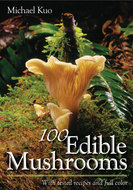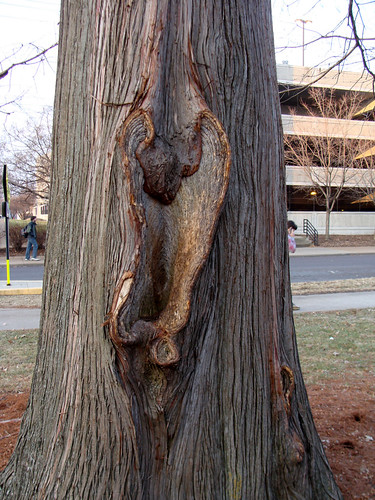It's a mushroom blog! I am crazy for wild mushrooms, and all their friends and associates. I go hiking in central Missouri, looking for mushrooms, and find lots of other woodland citizens along the way. Heavy on macro-photography, with bite-sized fact morsels throughout.
Showing posts with label Mycologista. Show all posts
Showing posts with label Mycologista. Show all posts
Wednesday, June 30, 2010
Blue Mushroom Sap--Lactarius indigo
Lactarius indigo. Click on it! View it as big as you can! Do it!
Sunday, June 27, 2010
Old polypore sculpture, Ganoderma applanatum
 |
| Ganoderma applanatum, "Artist's conk" |
Look, I don't make this stuff, I just find it
Here's another one
Six years after I posted this, I looked at it again, and now I think it's Ganoderma applanatum, an old one. The original post was "Fresh young polypore sculpture" and I had identified it as Ischnoderma resinosum. But now I don't remember where it was growing, and I don't have more details to refer to. I was overly eager, and fairly inexperienced. It's a phase many mushroom people go through. No shame.
Tuesday, May 11, 2010
Lovely mosses and lichens
Early spring, on a bluff. This beautiful composition was in a space about 3" square.
Tags:
lichen,
Missouri moss,
moss,
mosses and lichens,
Mycologista
Sunday, May 9, 2010
Happy Moth Day
 |
| Polyphemus moth cocoon |
I wanted to hike to a different spot, and I went back to the car to regroup. It was too warm to leave it in the car, and too dangerous for the cocoon to drag it around in my shirt pocket, so I found a nearby tree and laid it on the ground nearby, out of sight. I came back a half-hour later and it had emerged!
Here he is, well-camouflaged near the base of the tree.
 |
| Antheraea polyphemus |
It's a big, fat, beautiful male Polyphemus moth! Those huge feathery antennae are a sure sign it's a male. Nothing better for catching a female's pheromones on the wind, they tell me.
And to that poor lady I've never seen before who was going to her car with her three yellow labs while I was taking 136 pictures of this, who I told to "Put your dogs in the car and come here! You have to see this!," who was very good-natured and did put her dogs in the car and come over to see it, and took pictures with her cellphone and everything, and seemed to really enjoy it and thanked me sincerely for showing her, I'd like to say, "Thank you for indulging me, a perfect stranger, and sharing my excitement."
*Edit: I met some people on a trail 2-3 years later and we chatted briefly about the woods and our hikes, and she said, "You look familiar--are you the moth woman I met at Gans Creek?"--and I was.
Antennae to die for
His antennae are fully 3/4" wide, each. Doesn't get much better than this.
Here is the post describing my finding the cocoon and everything.
It's a male Polyphemus moth, Antheraea polyphemus.
Here's some good ID book links
A Field Guide to the MOTHS of Eastern North America (Peterson Field Guides)
Wednesday, May 5, 2010
Also, I found some morels, but I didn't care
The morels I found on this day were pretty much overshadowed by the emerging Polyphemus moth I found.
Black cup fungi
Everybody assumed these were Devil's Urn (Urnula craterium) except they're not growing in the right place, among some other features that didn't line up. U. craterium grows on smallish sticks. I found lots of these, all jammed up tight against the base of Eastern Red Cedars. They're also much smaller than devil's urns, biggest only about 1/2" across.
To be fair, the big one in the center (above) with the nice fringed edge probably IS a standard devil's urn. But all the little ones behind, not.
Michael Kuo himself, the rock star of mushroom book authors (his books are hugely useful and highly entertaining), has offered to take a closer look at them. His website, www.mushroomexpert.com, is the go-to site for mycophiles.
I'll eventually get around to sending some dried specimens to him. The poor guy, he's swamped with "What's THIS?" e-mails, including from me. Well, you makes your bed, you sleeps in it.
*Update: I've passed this around and a few actual mushroom people agree that it's probably Plectania. Or Pseudoplectania. Not much info out there on these for us amateurs.

It's really a great book. Too bad I don't actually OWN it.
*Edit sometime in fall, 2011: I own it now! I am proud and happy!
To be fair, the big one in the center (above) with the nice fringed edge probably IS a standard devil's urn. But all the little ones behind, not.
Michael Kuo himself, the rock star of mushroom book authors (his books are hugely useful and highly entertaining), has offered to take a closer look at them. His website, www.mushroomexpert.com, is the go-to site for mycophiles.
I'll eventually get around to sending some dried specimens to him. The poor guy, he's swamped with "What's THIS?" e-mails, including from me. Well, you makes your bed, you sleeps in it.
*Update: I've passed this around and a few actual mushroom people agree that it's probably Plectania. Or Pseudoplectania. Not much info out there on these for us amateurs.

It's really a great book. Too bad I don't actually OWN it.
*Edit sometime in fall, 2011: I own it now! I am proud and happy!
Killdeer protest
Hey! Look what happens when you get too close to a Killdeer on her nest, before she breaks and runs off with a fake broken wing, trying to lure you away.
I never knew about those beautiful orange under-feathers before.
Monday, April 19, 2010
Cecropia moth
 |
| Hyalophora cecropia |
Another three hours, now dark out, still there. It could be a female, I read they mostly sit around and put out pheromones, but the extra-large antennae say male, so who knows.
That fur! Those colors! I can't stand it!
 |
| Male Cecropia moth |
Friday, March 26, 2010
Thursday, September 24, 2009
Grisette--Amanita vaginata--and Clavulinopsis laeticolor

 "Grisette," Amanita vaginata.
"Grisette," Amanita vaginata.
Common name refers to a French working-class woman, usually a part-time "flirt;" from "gris" (grey), the color of the cheap unbleached clothing they wore.
Anyway, these mushrooms have characteristic striated cap edges, a ring and a nice volva.
Bonus: this photo appears in Michael Kuo's latest book, "Mushrooms of the Midwest"!
Tiny orange coral, probably Clavulinopsis laeticolor.
Anyway, these mushrooms have characteristic striated cap edges, a ring and a nice volva.
Bonus: this photo appears in Michael Kuo's latest book, "Mushrooms of the Midwest"!
Tiny orange coral, probably Clavulinopsis laeticolor.
Purple Russula & Fat Coral Mushroom



Lovely coral fungus, Ramaria sp.
Russula mariae (best guess). Russulas are not easy to identify without checking a lot of different features, none of which I was aware of when I found this.
Destroying Angel and Common Split-gill
 |
| Schizophyllum commune, "common split-gill" (very young ones) |
 |
| Amanita bisporigera, "Destroying Angel." Most field guides call this A. virosa (or A. verna, depending on whether or not it turns yellow when KOH is applied), but those turn out to be European species. |
 |
| Amanita bisporigera's large ring on stem |
Boletes and Tremella fuciformis with Ophiostoma epigloeum

Lumpy Bolete
Dimpled cap points to Leccinum, maybe.

Another bolete, slowly bruising blue
Little jelly (about 1-1/2")
 |
| Tremella fuciformis. |
See the little black spines? That's a parasitic fungus that only grows on T. fuciformis. I don't remember how I chanced upon that bit of information. I learned it as Ophiostoma epigloeum, apparently now it's Sporothrix epigloea.
Monday, September 14, 2009
Chanterelle motherlode!
Black-footed polypore, Polyporus badius
 Didn't know what these were for a while. They were pliable, and BIG. Underside white and smooth.
Didn't know what these were for a while. They were pliable, and BIG. Underside white and smooth.Polyporus badius.
These change appearance pretty dramatically over the course of their lives, very young ones are pale grey with a smooth rounded outline, from a distance they look like oyster mushrooms. They turn a dark reddish brown as they mature.
Sunday, September 13, 2009
Purple gills--Laccaria ochropurpurea
This is one of the very first mushrooms I photographed. I didn't know what the hell I was looking at.
It is Laccaria ochropurpurea, an old one. Young fresh ones have a cap like what you think a mushroom cap looks like.
This was the fateful day that I fell in love with mushrooms, my camera, and macro-nature photography. I was being taken to a spot where a friend had discovered chanterelles--as in, he had found some, didn't know what they were, looked them up, found they were choice edibles, picked some, ate some, and was taking me with him to pick more--and as we scouted them out, so many other mushrooms began to reveal themselves that I just didn't know how to act. They were everywhere. How many other times in my life of considering myself a nature-girl had I been hiking and somehow not seen them? Crazy. Just goes to show, you see what you're looking for.
I found many, many more of these throughout the season.
Below, why you shouldn't use your flash up close. Bleah.
Later I found there's a setting to back down the intensity of the flash (RYFM = Read Your F---ing Manual), but still, I've never been happy with the results. It seems to take away from the intimacy of the subject. It's a point-and-shoot camera, so my control is limited (not to disparage my camera--I love that thing--the worlds it has shown me--). But my future holds a different camera...
 |
| Aug. 29, 2009 |
This was the fateful day that I fell in love with mushrooms, my camera, and macro-nature photography. I was being taken to a spot where a friend had discovered chanterelles--as in, he had found some, didn't know what they were, looked them up, found they were choice edibles, picked some, ate some, and was taking me with him to pick more--and as we scouted them out, so many other mushrooms began to reveal themselves that I just didn't know how to act. They were everywhere. How many other times in my life of considering myself a nature-girl had I been hiking and somehow not seen them? Crazy. Just goes to show, you see what you're looking for.
I found many, many more of these throughout the season.
Below, why you shouldn't use your flash up close. Bleah.
Later I found there's a setting to back down the intensity of the flash (RYFM = Read Your F---ing Manual), but still, I've never been happy with the results. It seems to take away from the intimacy of the subject. It's a point-and-shoot camera, so my control is limited (not to disparage my camera--I love that thing--the worlds it has shown me--). But my future holds a different camera...
Subscribe to:
Posts (Atom)















